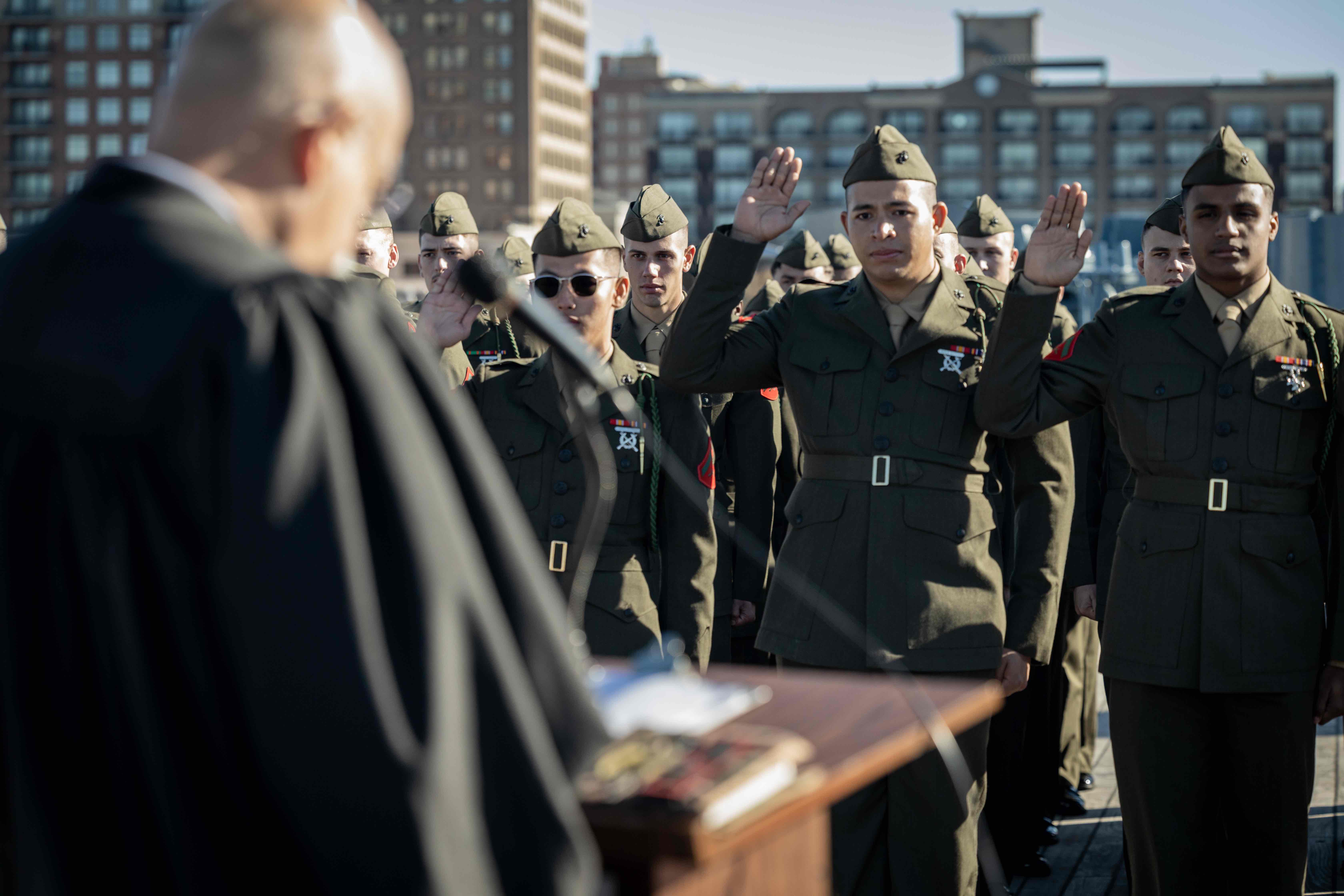
ANNAPOLIS, Md. – Fifty years after the United States turned to the all-volunteer force, a group of Marines gathered to hear outside experts discuss how to man the force between now and 2040.
The Marine Corps, like the other branches, faces a competitive recruiting environment, which it is trying to overcome with a variety of talent management programs. But Wednesday, the Marines took a listening role as they sat through multiple panels at the Naval Institute’s Jack C. Taylor Conference Center. Later, Marine leaders would take what they heard and aim to turn it into action, Assistant Commandant Gen. Eric Smith said during his opening remarks.
The Marines have turned to new ideas through their Talent Management 2030, the personnel side of the service’s Force Design 2030. The latest plan stresses retention and maturing the force over a high turnover rate and recruiting the service has been known for in the past. Now, the Marines need to figure out how to continue to recruit enough new Marines each year.
In Fiscal Year 2022, the Marines brought on 33,210 enlisted active-duty Marines, meeting the service’s recruiting goal, but commandant Gen. David Berger has raised concerns that it will not be able to keep meeting those goals.
“Nothing is off the table, except we’re not lowering our standards,” Smith said.
The military cannot be a family business, he said, after asking anyone in uniform to raise their hand if they had a family member who served. The majority raised their hands. Even Smith contributes to that family business. His son is a Marine.
“I really do have skin in this game, and this is personal for me,” he said.
With China as the pacing threat, the personnel numbers do not look good, Smith said. China has a larger population that can fill its military in the short term. In the United States, the numbers are smaller, reduced even further by fewer young people able to meet eligibility requirements and who have the desire to serve.
“It is just a matter of time before we are once again called to defend our nation and, perhaps, on our own shores,” he said.
The theatres where conflict could occur are expanding, said Jack Goldstone, chair of public policy at George Mason University. The highest growth of young populations is in Asia and Africa, he said.
China’s population growth is slowing, which could lead to President Xi Jinping pushing for a Taiwan invasion in the next 10 years while the population is still strong, Goldstone said. But the population increases in African countries are going to also pose a challenge for the military.

China can do more than outmatch the United States in manpower, said Francis Hoffman, a distinguished research fellow at National Defense University. The country also has economic and technological advantages.
Hoffman does not necessarily agree with the idea of China as a pacing threat, saying it is too general. There are multiple futures for which the U.S. needs to prepare, he said.
Marines of the future will need to be more tech-savvy and collaborative, he said.
Technology can help address manpower concerns, said Paul Scharre, vice president at Center for New American Studies. But the Marine Corps will have to ask what can machines do and what still needs a human touch or decision.
Looking toward the future, one aspect that might need to change is the overhaul of the officer system, Scharre said. He questioned why recent college graduates, who go through officer programs, are put into the middle manager version of a position in the military. The system harkens back to the British influence on the country, he said.
“It’s fundamentally unAmerican,” Scharre said. “I don’t know why we do it.”
Instead, there needs to be more education available for enlisted service members so they can get into leadership positions, bringing their time and experience into the positions, he said.
Identifying what the 2040 force will face is one challenge. The other is figuring out how to ensure there are enough people that want to and can serve.
There are systemic issues that are affecting the population that can serve. Obesity, drug use and felony convictions pick away at the population of young Americans targeted by the services. Roughly one in seven men in the United States has a felony conviction, said Nicholas Eberstadt, Henry Wendt chair in political economy at the American Enterprise Institute.
Then there is the issue of willingness to serve. Only half of Americans 18-29 years old think the military has a positive effect, said Richard Fry, senior researcher at the Pew Research Center.
Nationally, fertility rates are dropping – there were 58.21 births per 1,000 women in 2019 versus 70.77 in 1990, according to the Census Bureau – but immigration is rising, which means that there will still be a number of young adults, Fry said. Immigrants are a population that the military can pull from, Goldstone said. There are young people who would take the opportunity to join the military as a way to get citizenship.
“So just like all the tech companies in Silicon Valley that are recruiting engineers from around the world, the military should, I think, take a leading role in exploring ways to draw on the strength of immigrants and have immigrants a big part of our National Service and National Defense as they always have been,” he said.
The military needs to expand the pools where it recruits, said Lindsay Cohn, an associate professor at the Naval War College.

“The idea that you should only fish where there are fish, I get that it makes total sense, Cohn said. “But you have to expand your idea of who the fish are. Because if you just go to the places where you have an easy time recruiting numbers, you’re not going to get the force that you need.”
This includes seeking out more women to serve, she said. In addition to seeking out more places to find recruits, the military needs to go to populations that have been less tapped, like women, said Meredith Kleykamp, director of the Center for Research on Military Organization at the University of Maryland.
Recruiting messaging also needs to change, Kleykamp said. Right now, the message being shared is the one that encouraged current Marine leadership to join. But the Marines need to appeal to future generations.
“And those are the people we need to recruit and the institution needs to be a place that is seen as a desirable place to go for people who both want to serve the nation and fight and defend the country but also who have a very clear sense of justice about our collective national values,” Kleykamp said.
It is not that young people do not want to serve, Cohn said. They just want to serve different communities. The service branches need to appeal to young Americans as their community.
Younger people also see problems as not requiring force, and if there’s no need for force, the military has less importance, Cohn said. When it comes to China, young Americans think the country will affect their lives but they do not see it as a military problem.
That mindset needs to change in order to get more people who want to serve, she said.
The military also needs to figure out how to better recruit those who have already been to college or those considered difficult to recruit, Kleykamp said.
The military does not want to lower its standards, but there are military policies that are kept because it has always been that way not function, Cohn said. She raised the question of haircuts and if it was because of function or history.
Marijuana use is another issue that could be changed, she said. As a compromise, the military could let in people who have used marijuana in the past but not allow use once recruits are in the service.
Medication is another area that can be examined as society as a whole is more medicated now, Cohn said.
Recruiting is about getting those who do not have the desire to serve into the military, said Beth Asch, a senior economist at RAND. Incentives offered by the service branches are good, but they only help push those already considering service.
The military is stressing its recruiting system, said Todd Harrison, managing director at Metrea Strategic Insights. The service branches have made do, but it comes at the cost of lowering standards.
“I don’t think it’s a money problem,” Harrison said. “I think it is a culture problem. It is a career model problem. And then there are some limitations that we’ve artificially imposed on ourselves that are holding us back and making it difficult to recruit the people that we need.”

The military’s reliance on the pyramid model, where many people start at the bottom and few rise to the top is also hurting the military, Harrison said.
“We build ourselves in an inefficient way to try to maintain this pyramid structure,” he said.
It also leads to an up-and-out problem, where those who want to stay are pushed out because they are not promoted, Cohn said.
The military needs to move beyond the industrial model that drove it in the past, he said, a sentiment Cohn echoed. It is not about putting bodies in the Marines anymore, they said. It’s about finding the best and the brightest.
“That is the Marine Corps today, that is who you are today,” Harrison said. “Is that who we want to be in the future?”





